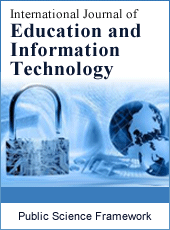International Journal of Education and Information Technology
Articles Information
International Journal of Education and Information Technology, Vol.1, No.1, Apr. 2015, Pub. Date: Mar. 31, 2015
Examining Students’ Perception & Efficacy of Using Technology in Teaching English
Pages: 11-19 Views: 3941 Downloads: 8202
[01]
Hussain Ahmed Liton, English Language Centre, Jazan University, Jazan, Saudi Arabia.
The widespread growing ubiquity of media technology has heightened the remarkable changes in higher education over a period of time. Successful technology-mediated teaching-learning has already created new trends and impact on students’ learning motivation and on emerging new models of pedagogy. Technology in education has accelerated and promoted students’ 21st century literacy skills related to workplace needs. Behind such promising perspective, this paper attempts to examine students’ perception and efficacy of technology application in English language teaching-learning practices in the real classroom situation in the tertiary level. To this end, this study investigates students’ real perception and efficacy of technology-mediated language classroom through survey questionnaire and observation. The data were collected through questionnaire from a total of 33 EFL students from some renowned universities of Asia. The research findings revealed that the students are immersed in the learning process actively and enthusiastically but many don’t know how to integrate technologies into their learning process. It, therefore, suggests that technology-facilitated EFL text curriculum needs to be proposed and teacher trainers should arrange training for EFL students on how to integrate technology into their learning practices. The study also recommended that classroom should be equipped with the cutting-edge technologies that impact on students’ success in a technology-driven learning situation. In addition, it underlines emerging new trends of pedagogies and ‘new learning spaces’ to facilitate learners’ needs as citizens in an increasingly globalized and digitalized world.
Digital Literacy, Asynchronous/ Synchronous, Digital Natives, Learners’ Autonomy, Using Technology to Enhance Learning
[01]
Alipanahi, F., & Iran, A. T. ( 2013). The relation between Iranian EFL teachers' attitude towards ICT and their perception of ICT attributes, cultural perception of ICT, and computer competence. International Journal of Instructional Technology and Distance Learning, 10(2), 23-34.
[02]
Anderson, R. E., & Dexter, S. L. (2000). School Technology Leadership:Incidence and Impact (Teaching, Learning, and Computing: 1998 National Survey Report#6). Irvine, CA: Center for Research on Information Technology and Organizations, University of California, Irvine.
[03]
Beauvois, M. (1998). Conversations in slow motion: Computer-mediated communication in the foreign Language Classroom. The Canadian Modern Language Review, 54(2), 198-217.
[04]
Cantoni, L. (2011). The So-called Generation Y, Learning and Digital Technologies: What’s Real and What’s Just Hype in a Fortunate Label. International Conference of E-Learning and Distance Learning. Riyadh: National Center for E-Learning and Distance Learning.
[05]
Centre, O. C. (2002). OCLC White Paper on the Information Habits of College Students: How academic librarians can influence students web-based information choices. Retrieved December 21, 2012, from Computer Library Center: http://www.mnstate.edu/schwartz/informationhabits.pdf
[06]
Chai, L. T., Hong, Y. K., & Ching, C. C. (2010). EXPLORING MALAYSIAN TRAINEE TEACHERS’ ADOPTION OF THE INTERNET AS INFORMATION TOOL. International Journal of Instruction, 3(2), 25-38.
[07]
Creswell, J. W. (2003). Research Design: Qualitative, Quantitative, and Mixed Approaches. Second Revised ed. London: Sage Publications Ltd.
[08]
Gonzenbach, N. M., & Davis, D. C. (1999). Business employees’ perceptions of content areas to be included in an information systems technology curriculum. NABTE Review, 62-85.
[09]
Hall, M., & Elliott, K. M. (2003). Diffusion of technology into the teaching process: Strategies to encourage faculty members to embrace the laptop environment. Journal of Education for Business, 78(6), 30-307.
[10]
Harrison, A. W., & Rainer, R. K. (1992). The Influence of Individual Differences on Skill in End-User Computing. Journal of Management Information Systems, 9(1), 93-111.
[11]
Hartman, K., Neuwirth, C., Kiesler, S., Sproull, L., Cochran, C., Palmquist, M., & Zabrow, D. (1995). Patterns of social interaction and learning to write: Some effects of network technologies. In B. Z, & C. M (Eds.), Computer-mediated communication and the online classroom (pp. 47-78). Creskill, NJ: Hampton Press, Inc.
[12]
Khan, S. H., Hasan, M., & Clement, C. K. (2012, July). BARRIERS TO THE INTRODUCTION OF ICT INTO EDUCATION IN DEVELOPING COUNTRIES: THE EXAMPLE OF BANGLADESH. International Journal of Instruction, 5(2), 61-80.
[13]
Liton, H. A. (2014). Exploring Teachers’ Attitude towards ICT integration into ESP and EFL Classroom. International Journal of Instructional Technology and Distance Learning, 11(5), 3-18.
[14]
Marshall, C., & Rossman, G. B. (2006). Designing Qualitative Research. London: Sage Publications Ltd. (Inc 1st pub. 1989).
[15]
Niederhauser, D. S., Salem, D. J., & Fields, M. (1999). Exploring teaching, learning, and instructional reform in an introductory technology course. Journal of Technology and Teacher Education, 7(2), 153-172.
[16]
Oblinger, D., & Oblinger, J. L. (2005). Educating the Net Generation. Carolina: North Carolina State University: EDUCASE.
[17]
Prensky, M. (2001). Digital Natives, Digital Immigrants. On the Horizon, 1-6.
[18]
Son, J. B. (2002). Computers, Learners and Teachers: Teamwork in the CALL classroom. English Language Teaching, 239-252.
[19]
Windham, C. (2005). The student’s perspective. In D. G. Oblinger, & J. L. Oblinger (Eds.), Educating the net generation (pp. 5.1-5.15). Washington, DC: Educause.

ISSN Print: 2381-7410
ISSN Online: 2381-7429
Current Issue:
Vol. 5, Issue 1, March Submit a Manuscript Join Editorial Board Join Reviewer Team
ISSN Online: 2381-7429
Current Issue:
Vol. 5, Issue 1, March Submit a Manuscript Join Editorial Board Join Reviewer Team
| About This Journal |
| All Issues |
| Open Access |
| Indexing |
| Payment Information |
| Author Guidelines |
| Review Process |
| Publication Ethics |
| Editorial Board |
| Peer Reviewers |


